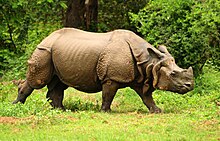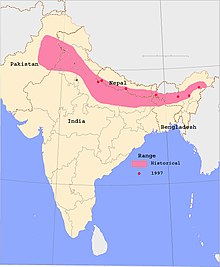| Indian rhinoceros Temporal range:
| |
|---|---|

| |
| An Indian rhinoceros in Kaziranga National Park | |
| Scientific classification | |
| Domain: | Eukaryota |
| Kingdom: | Animalia |
| Phylum: | Chordata |
| Class: | Mammalia |
| Order: | Perissodactyla |
| Family: | Rhinocerotidae |
| Genus: | Rhinoceros |
| Species: | R. unicornis
|
| Binomial name | |
| Rhinoceros unicornis | |

| |
| Indian rhinoceros historical range | |
The Indian rhinoceros (Rhinoceros unicornis), also known as the greater one-horned rhinoceros, great Indian rhinoceros, or Indian rhino for short, is a rhinoceros species native to the Indian subcontinent. It is the second largest extant species of rhinoceros, with adult males weighing 2.07–2.2 tonnes and adult females 1.6 tonnes. The skin is thick and is grey-brown in colour with pinkish skin folds. They have a single horn on their snout that grows to a maximum of 57.2 cm (22.5 in). Their upper legs and shoulders are covered in wart-like bumps, and aside from the eyelashes, ear fringes and tail brush, Indian rhinoceroses are nearly hairless.
The Indian rhinoceros is a largely solitary animal, only associating in the breeding season and when rearing calves. They are grazers, and their diet is mainly grass, but may also include twigs, leaves, branches, shrubs, flowers, fruits, and aquatic plants. Females give birth to a single calf after a gestation of 15.7 months; the birth interval is 34 to 51 months. Captive individuals can live up to 47 years. The Indian rhinoceros is susceptible to diseases such as anthrax, and those caused by parasites such as leeches, ticks, and nematodes.
It is listed as Vulnerable on the IUCN Red List, as populations are fragmented and restricted to less than 20,000 km2 (7,700 sq mi). As of August 2018, the global population was estimated to comprise 3,588 individuals. Indian rhinos once ranged throughout the entire stretch of the Indo-Gangetic Plain, but excessive hunting and agricultural development reduced its range drastically to 11 sites in northern India and southern Nepal. In the early 1990s, between 1,870 and 1,895 Indian rhinos were estimated to have been alive. Since then, numbers have increased due to conservation measures taken by the government. However, poaching remains a continuous threat.
- ^ a b Ellis, S. & Talukdar, B. (2019). "Rhinoceros unicornis". IUCN Red List of Threatened Species. 2019: e.T19496A18494149. doi:10.2305/IUCN.UK.2019-3.RLTS.T19496A18494149.en. Retrieved 16 January 2022.
